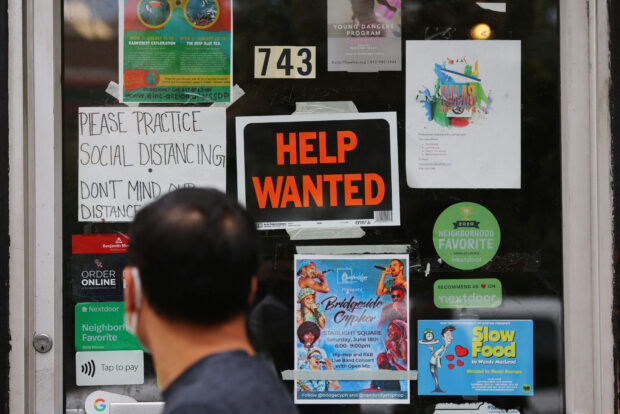
A pedestrian passes a “help wanted” sign in the door of a hardware store in Cambridge, Massachusetts, U.S., July 8, 2022. REUTERS/Brian Snyder/File photo
WASHINGTON – U.S. job openings dropped to their lowest level in nearly two years in February, suggesting that labor market conditions were finally easing, welcome news for the Federal Reserve as it considers whether to pause its interest rate hiking cycle.
Despite the larger-than-expected decline in job vacancies reported by the Labor Department on Tuesday, the labor market remains tight, with 1.7 job openings for every unemployed person in February, down from 1.9 in January. Fed officials have been closely monitoring this ratio. Friday’s employment report for March will shed more light on the labor market’s health.
The broad drop in job openings occurred before the recent financial market turmoil, which led to tighter credit conditions and sparked fears of widespread job losses in the economy.
“Arguably this report provides the first evidence of an easing in labor market conditions, which nonetheless remain very tight,” said Conrad DeQuadros, senior economic advisor at Brean Capital in New York.
Job openings, a measure of labor demand, were down 632,000 to 9.9 million on the last day of February, the lowest level since May 2021, the monthly Job Openings and Labor Turnover Survey, or JOLTS report, showed. They fell 1.3 million in first two months of this year.
Economists polled by Reuters had forecast 10.4 million job openings. The decline was led by the professional and business services sector, where job openings fell 278,000. There were 150,000 fewer vacancies in the healthcare and social assistance industry. Job openings in the transportation, warehousing and utilities sector fell by 145,000.
But the construction industry sought more workers, with job openings increasing by 129,000. There were an additional 38,000 vacancies in the arts, entertainment and recreation sector. Regionally, the decline was concentrated in the Midwest, South and West. The Northeast reported a moderate drop.
Small and medium-sized businesses, who have been the drivers of job growth, accounted for most of the decrease, with establishments with a 1,000 workers and more reporting a small reduction in job openings.
The job openings rate fell to 6 percent from 6.4 percent in January.
Dangerous situation
Stocks on Wall Street were trading lower. The dollar fell against a basket of currencies. U.S. Treasury prices rose.
The decrease in vacancies suggested that the Fed’s aggressive rate hikes to tame high inflation were starting to yield results. But against the backdrop of banks tightening lending standards, some economists worried about a sharp weakening in the labor market. There has been a raft of layoffs, mostly in the technology and housing sectors.
The Fed last month raised its benchmark overnight interest rate by a quarter of a percentage point, but indicated it was on the verge of pausing further rate hikes due to financial market turmoil. The U.S. central bank has hiked its policy rate by 475 basis points since last March from the near-zero level to the current 4.75 percent-5 percent range.
“The labor market was starting to lose steam even before the banking crisis hit the economy in March and this sets up a dangerous situation where tighter credit conditions could prompt actual layoffs in the months ahead as corporations struggle to get costs under control,” said Christopher Rupkey, chief economist at FWDBONDS in New York.
Hiring fell to 6.2 million from 6.3 million in January. That lowered the hires rate to 4 percent from 4.1 percent in the prior month.
Even as job openings declined, the number of people voluntarily quitting their positions increased 146,000 to 4.0 million. The resignations were mostly in small businesses.
About 115,000 people resigned in the professional and business services sector. In the accommodation and food services industry, 93,000 workers quit, while wholesale trade reported 31,000 resignations. About 18,000 educational services workers quit in February. But there were fewer quits in the finance and insurance industry, where resignations fell 39,000.
The quits rates, which is viewed as a measure of labor market confidence, rose to 2.6 percent from 2.5 percent in January. It is, however, down from the 2.9 percent-3.0 percent range in late 2021 and early 2022 when job hopping was at its peak.
“The more settled state of workers should contribute to a further drop in job openings in the months ahead, as fewer departures reduce the number of new vacancies,” said Sarah House, a senior economist at Wells Fargo in Charlotte, North Carolina. “With retention less of an issue for employers, the weakening trend in the quits rate should help to further reduce wage growth.”
Layoffs and discharges dropped 215,000 to 1.5 million, concentrated in small and medium-sized businesses. The layoffs rate dropped to 1 percent from 1.1 percent in January.
“Companies are holding on to workers due to the tight labor market but are starting to think twice about adding more expenses to their books,” said Ben Ayers, senior economist at Nationwide in Columbus, Ohio.
READ MORE:
https://business.inquirer.net/385892/u-s-weekly-jobless-claims-increase-labor-market-still-tight